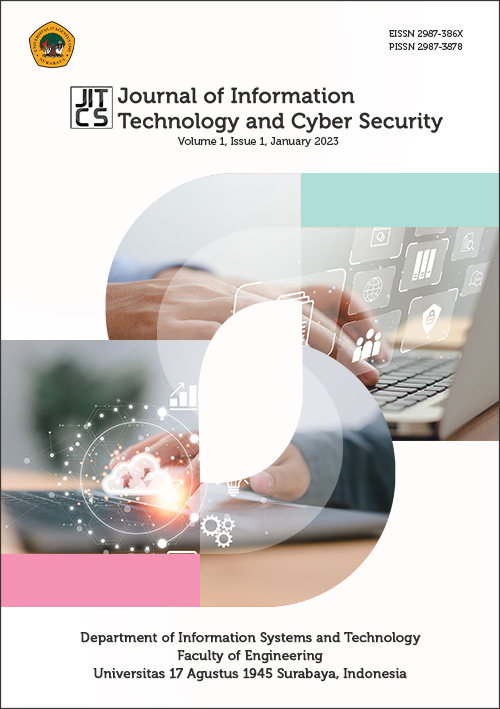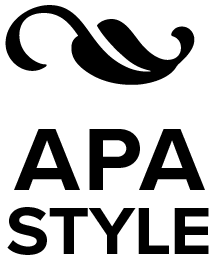The Utilization of Information System for Crime Rate Modelling in Surabaya Using K-means
Abstract
This study aims to model the crime rate in the city of Surabaya using the k-means clustering method. The data used is crime data that occurred in Surabaya in previous years, which includes the type of crime, location of crime, and crime rate. The k-means clustering method is used to classify crime data in the Surabaya area for 2020-2022 consisting of cluster 3, namely areas with moderate crime rates covering 6 sub-districts (1,260 cases), cluster 1 with areas with high crime rates, namely 12 sub-districts with 2,363 cases, and cluster 2 areas with low crime rates consisting of 13 districts with 2,178 cases based on data on the number of crimes. The geospatial visualization system is used to visually display modeling results, making it easier for interested parties to identify the location of a crime. The results of this study are expected to provide useful information for interested parties, such as the police and the community, in taking preventive action regarding crime rates in Surabaya.
Downloads
References
Anshori, M. H., & Misbachudin, M. (2017). Rancang Bangun Simulasi Safety Starting System pada Mobil L300. Polhasains: Jurnal Sains Dan Terapan Politeknik Hasnur, 5(2), 27–31. https://ejournal.polihasnur.ac.id/index.php/phssains/article/view/208
Arfani, F., & Nashrullah, H. (2022, March). Polrestabes Surabaya ungkap 58 kasus kejahatan jalanan. Antara News. https://www.antaranews.com/berita/2741061/polrestabes-surabaya-ungkap-58-kasus-kejahatan-jalanan
Arsista, G. (2022). Alert! Kasus Curanmor di Surabaya Meningkat. Suara Surabaya.
Astuti, Y. (2018). Program Smart City Kota Makassar (Studi Pemanfaatan Closed Circuit Television di Kota Makassar). In Universitas Muhammadiyah Makassar. https://digilibadmin.unismuh.ac.id/upload/4178-Full_Text.pdf
Bindosano, K. A., Yudono, A., & Hasyim, A. W. (2022). Arahan Pengurangan Kriminalitas di Kota Jayapura. Planning for Urban Region and Environment Journal (PURE), 11(4), 231–240.
Gunawan, M., & Aditya, T. (2019). Analitik Geovisual Pola Kejadian dan Pergerakan Kriminalitas Berbasis Data Media Sosial. Prosiding Seminar Nasional GEOTIK, 335–345.
Hapsari, D. P. T., & Widodo, E. (2017). Pengelompokan Daerah Rawan Kriminalitas di Indonesia Menggunakan Analisis k-Means Clustering. Prosiding SI MaNIs (Seminar Nasional Integrasi Matematika Dan Nilai Islami), 1(1), 147–153. http://conferences.uin-malang.ac.id/index.php/SIMANIS/article/view/52
Himawan, A. (2023). Optimalisasi Pemolisian Masyarakat Guna Memberikan Rasa Aman dan Rasa Nyaman pada Masyarakat, Sudut Pandang Ilmu Psikologi. Jurnal Litbang Polri, 26(1), 30–40. https://jlp.puslitbang.polri.go.id/jlp/LitbangPOLRI/article/view/197
Kendall, K. E., & Kendall, J. E. (2011). Systems Analysis and Design (8th ed.). Prentice Hall.
Larose, D. T., & Larose, C. D. (2014). Discovering Knowledge in Data: An Introduction to Data Mining. In John Wiley & Sons. https://doi.org/10.1002/9781118874059
Mulyani, H., Nurjaman, J., & Nugraha, M. (2020). Geographic Information Systems for Crime Prone Areas Clustering. JOIN (Jurnal Online Informatika), 5(2), 227–232. https://doi.org/10.15575/join.v5i2.599
Nurjoko, N., Dwirohayati, D., & Sudibyo, N. H. (2020). Sistem Informasi Pemetaan Wilayah Rawan Kriminalitas Polresta Bandar Lampung Menggunakan K-Means Clustering. Teknika, 14(2), 127–135.
Nurman, R. M. (2007). Sistem Informasi Pemetaan Profil Kriminalitas Berbasis Web (Studi Kasus: Kejahatan Konvensional Kota Bogor). In Institut Pertanian Bogor.
Prasetyo, E. (2014). Data Mining : mengolah data menjadi informasi menggunakan Matlab. Andi Publisher.
Rahayu, S., Nugrahadi, D. T., & Indriani, F. (2014). Clustering Penentuan Potensi Kejahatan Daerah di Kota Banjarbaru dengan Metode k-Means. KLIK (Kumpulan JurnaL Ilmu Komputer), 01(01), 33–45.
Rijali, A. (2018). Analisis Data Kualitatif. Alhadharah: Jurnal Ilmu Dakwah, 17(33), 81–95. https://doi.org/10.18592/alhadharah.v17i33.2374
Setiawan, I., Dede, M., Sugandi, D., & Widiawaty, M. A. (2019). Investigating Urban Crime Pattern and Accessibility Using Geographic Information System in Bandung City. KnE Social Sciences, 535–548. https://doi.org/10.18502/kss.v3i21.4993
Copyright (c) 2023 The Author(s)

This work is licensed under a Creative Commons Attribution-NonCommercial-ShareAlike 4.0 International License.
Copyright Notice based on COPE (Committee on Publication Ethics) for JITCS: Journal of Information Technology and Cyber Security
-
Ownership and Copyright:
- JITCS: Journal of Information Technology and Cyber Security respects the intellectual property rights of authors. The copyright for individual articles published in JITCS is retained by the respective authors, unless otherwise specified.
- The articles published in JITCS are licensed under a Creative Commons Attribution-NonCommercial-NoDerivatives 4.0 International License (CC BY-NC-ND 4.0), which permits use and distribution in any medium, provided the original work is properly cited, the use is non-commercial, and no modifications or adaptations are made.
- JITCS serves as the initial publisher of the articles, providing them with the first publication platform.
-
Permissions and Usage:
- Distribution for Non-Commercial Purposes: Permitted: Users are allowed to distribute the article for non-commercial purposes, provided the original work is properly cited and no modifications or adaptations are made.
- Distribution for Commercial Purposes: Not Permitted: The article may not be distributed for any commercial purposes without obtaining prior written permission from the author(s).
- Inclusion in a Collective Work (e.g., Anthology) for Non-Commercial Purposes: Permitted: Users are allowed to include the article in a collective work, such as an anthology, as long as the use is non-commercial and the work remains unchanged.
- Inclusion in a Collective Work for Commercial Purposes: Not Permitted: The article may not be included in any collective work or anthology intended for commercial purposes without prior permission from the author(s).
- Creation and Distribution of Revised Versions, Adaptations, or Derivative Works (e.g., Translation) for Non-Commercial Purposes: Not Permitted: Users may not create or distribute revised versions, adaptations, or derivative works, including translations, for non-commercial purposes.
- Creation and Distribution of Revised Versions, Adaptations, or Derivative Works for Commercial Purposes: Not Permitted: Users may not create or distribute revised versions, adaptations, or derivative works, including translations, for commercial purposes.
- Text or Data Mining for Non-Commercial Purposes: Permitted: Users are permitted to engage in text or data mining of the article for non-commercial research purposes, provided the original work is properly attributed.
- Text or Data Mining for Commercial Purposes: Not Permitted: Users may not engage in text or data mining of the article for commercial purposes without obtaining explicit permission from the author(s).
-
Attribution and Citation:
- Proper attribution and citation of the published work should be provided when using or referring to content from JITCS. This includes clearly indicating the authors, the title of the article, the journal name (JITCS), the volume/issue number, the publication year, and the article's DOI (Digital Object Identifier) when available.
- When adapting or modifying the published content, proper attribution to the original source should be given, and the adapted or modified content should be shared under the same CC BY-NC-ND 4.0 license.
-
Plagiarism and Copyright Infringement:
- JITCS considers plagiarism and copyright infringement as serious ethical violations. Authors are responsible for ensuring that their submitted work is original and does not infringe upon the copyright or intellectual property rights of others.
- Any allegations of plagiarism or copyright infringement will be investigated promptly and thoroughly. If proven, appropriate actions, including rejection of the manuscript, retraction of the published article, or other corrective measures, will be taken.
-
Open Access Licensing:
- JITCS supports open access publishing and encourages authors to consider publishing their work under the CC BY-NC-ND 4.0 license to promote the dissemination and use of knowledge in the field of information technology and cyber security.
- The specific terms and conditions of the CC BY-NC-ND 4.0 license will be clearly indicated on the published articles.
-
Policy Review: This Copyright Notice will be periodically reviewed and updated to ensure its continued relevance and compliance with copyright laws, ethical standards, and open access principles in scholarly publishing. Any updates or revisions to the notice will be communicated to the relevant stakeholders.
By adhering to this Copyright Notice, JITCS aims to protect the rights of authors, promote proper attribution and citation practices, and facilitate the responsible and legal use of the published content in accordance with the CC BY-NC-ND 4.0 license.




